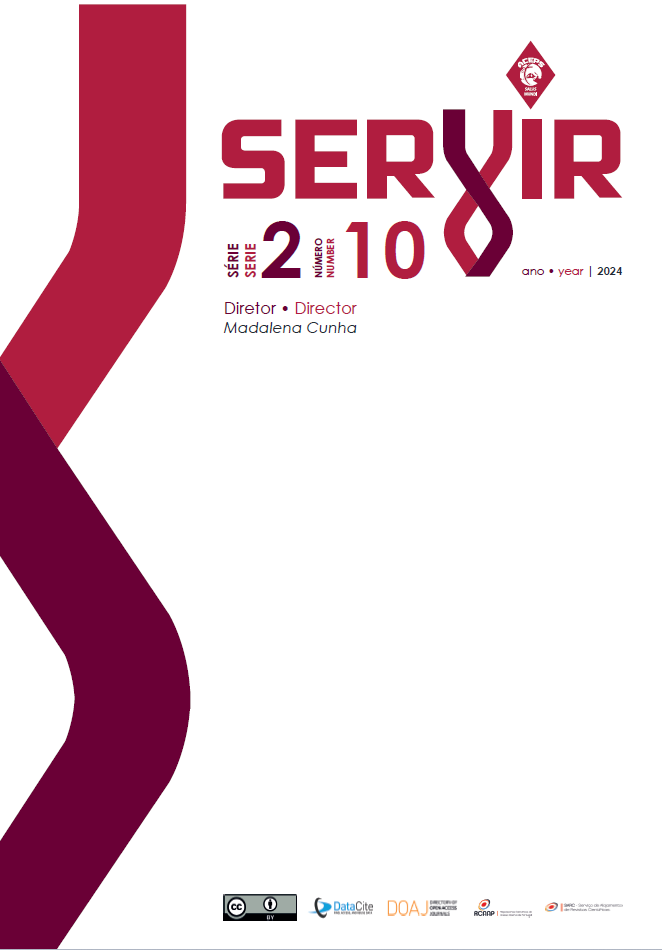Sleep-promoting nursing interventions in the pediatric population
an integrative literature review
DOI:
https://doi.org/10.48492/servir0210.38150Keywords:
Sleep, Health Promotion, Pediatric NursingAbstract
Introduction: The consequences of sleep deprivation on children are expressed through their behavior, learning and development and can have short and long-term consequences with an impact not only on the child/adolescent, but also on their family.
Objective/s: To identify in the scientific literature nursing interventions to improve sleep in the pediatric population.
Methods: Integrative Literature Review in the following databases: CINHAL Complete; MEDLINE Complete; Nursing & Allied Health Collection: Comprehensive; Cochrane Central Register of Controlled Trials; Cochrane Database of Systematic Reviews; Cochrane Methodology Register; Library, Informations Science & Technology Abstracts; MedicLatina and Cochrane Clinical Answers. The MeSH (Medical Subject Heading) terms, PICO acronym, and previously defined inclusion and exclusion criteria were used.
Results: Of the 364 articles, 14 were included for analysis. Sleep-promoting interventions include the training of nurses, increasing the knowledge of parents, children and adolescents.
Conclusion: There was a need for intervention on the part of nurses to train and increase the knowledge of parents and children, with a view to improving the quality of sleep and, consequently, improving the quality of life of children/adolescents and families.
Downloads
References
Caulfield, A. (2011). The specialist nurse in the field of childhood sleep disorders. Community practitioner, 84(2), 32-35.
Davis, K., Parker, K. & Montgomery, G. (2004). Sleep in infants and young children: Part One: Normal sleep. Journal of pediatric health care 18(2), 65–71. https://doi.org/10.1016/s0891-5245(03)00149-4
El Halal, C. D. S., & Nunes, M. L. (2019). Sleep and weight-height development. Jornal de pediatria, 95 Suppl 1, 2–9. https://doi.org/10.1016/j.jped.2018.10.009
Direção Geral de Saúde (2013). Programa Nacional de Saúde Infantil e Juvenil. https://www.dgs.pt/documentos-e-publicacoes/programa-tipo-de-atuacao-emsaudeinfantil-e-juvenil-png.aspx
Fogg, N., & Johnson, A. (2015). Child and Adolescent Sleep Paterns and Early School Start Times: Recognizing the Role of the Pediatric Nurse. Journal of pediatric nursing, 30(4), 628–631. https://doi.org/10.1016/j.pedn.2015.04.005
Hall, W., Causon, M., Carty, E., Jenssen, P. & Saunders, R. (2006). Effects on parents of an intervention to resolve infant behavioral sleep problems. Pediatric Nursing, 32(3), 243-250.
Hewitt, L., Frohmuller, C., Wall, J. & Okely, A. (2022). Clinician and early childhood educator knowledge and advice given to parents regarding physical activity, screen time and sleep: an observational study. Journal of Pediatric Nursing, 66, 143-150. https://doi.org/10.1016/j.pedn.2022.06.010
Hiscock, H. & Davey, M. (2018). Sleep disorders in infants and children. Journal of Pediatrics and Child Health, 54(9), 941–944. https://doi.org/10.1111/jpc.12033
Jha, V.M., & Jha, S.K. (2020). Sleep: Neural Optimization as an Ultimate Function for Memory Consolidation. In: Sleep: Evolution and Functions. Springer, Singapore. https://doi.org/10.1007/978-981-15-7175-6_5
Johansson, A., Petrisko, M. & Chasens, E. (2016). Adolescent sleep and the impact of technology use before sleep on daytime function. Journal of Pediatric Nursing, 31(5), 498-504. https://doi.org/10.1016/j.pedn.2016.04.004
Koulouglioti, C., Cole, R., Moskow, M., McQuilian, B., Ann-Carno, M. & Grape, A. (2014). The longitudinal association of young children’s everyday routines to sleep duration. Journal of pediatric health care, 28(1), 80–87. https://doi.org/10.1016/j.pedhc.2012.12.006
Lin, Y., Kuo, S., Chang, Y., Lin, P., Lin, Y., Lee, P., Lin, P. & Chen, S. (2021). Effects of parental education on screen time, sleep disturbances and psychological adaptation among Asian preschoolers: a randomized controlled study. Journal of Pediatric Nursing, 56, 27-34. https://doi.org/10.1016/j.pedn.2020.07.003
Mindell, J., & Owens, J. (2003). Sleep problems in pediatric practice: clinical issues for the pediatric nurse practitioner. Journal of pediatric health care, 17(6), 324–331. https://doi.org/10.1016/s0891-5245(03)00215-3
Oliveira, G., Silva, I. & Oliveira, E. (2019). O sono na adolescência e os fatores associados ao sono inadequado. Revista Brasileira de Pesquisa em Saúde, 21(1), 135-145. https://doi.org/10.21722/rbps.v21i1.26477
Pacheco, D. & Callender, E. (2023). Bedtime routines for children. https://www.sleepfoundation.org/children-and-sleep/bedtime-routine
Peters, M., Marnie, C., Tricco, A. C., Pollock, D., Munn, Z., Alexander, L., McInerney, P., Godfrey, C. M., & Khalil, H. (2020). Updated methodological guidance for the conduct of scoping reviews. JBI evidence synthesis, 18(10), 2119–2126. https://doi.org/10.11124/JBIES-20-00167
Rana, M., Allende, C., Latorre, T., Astorga, K., & Torres, A. (2019). Sueño em los ninos: fisiología y actualizacion de los últimos conocimientos [Sleep in children: physiology and update of a literature review]. Medicina, 79(3), 25–28.
Smaldone, A., Honig, J. & Byrne, M. (2009). Does assessing sleep inadequacy across its continuum inform associations with child and family health? Journal of pediatric health care, 23(6), 394–404. https://doi.org/10.1016/j.pedhc.2008.10.006
Tähkämö, L., Partonen, T., & Pesonen, A. (2018). Systematic review of light exposure impact on human circadian rhythm. Chronobiology international, 36(2), 151– 170. https://doi.org/10.1080/07420528.2018.1527773
Tekcan, P., Çaliskan, Z. & Kocaöz, S. (2020). Sleep Quality and related factors in Turkish high school adolescents. Journal of Pediatric Nursing, 55, 120-125. https://doi.org/10.1016/j.pedn.2020.07.020
Thome, M. & Skuladottir, A. (2005). Evaluating a family-centred intervention for infant sleep problems. Journal of Advanced Nursing, 50(1), 5-11. https://doi.org/10.1111/j.1365-2648.2004.03343.x
Trindade, C. & Ramos, A. (2020). Influência dos programas de educação sobre o sono de crianças e adolescentes: revisão integrativa. Acta Paulista de Enfermagem, 33, 1-9. https://doi.org/10.37689/acta-ape/2020AR01936
Vallido, T., Jackson, D. & O’Brien, L. (2010). Nurses’ management of adolescent sleep disturbance: a qualitative study. Journal of Clinical Nursing, 19(3-4), 324-331. https://doi.org/10.1111/j.1365-2702.2009.03059.x
Ward, T., Rankin, S. & Lee, K. (2007). Caring for children with sleep problems. Journal of Pediatric Nursing, 22(4), 283-296. https://doi.org/10.1016/j.pedn.2007.02.006
Whittemore, R., & Knafl, K. (2005). The integrative review: updated methodology. Journal of advanced nursing, 52(5), 546–553. https://doi.org/10.1111/j.1365-2648.2005.03621.x
Published
How to Cite
Issue
Section
License
Copyright (c) 2024 Rita Vilalobos Pinto, Sofia Silva, Rita Fernandes

This work is licensed under a Creative Commons Attribution 4.0 International License.
In order to promote the free circulation of knowledge, Servir is open access journal. All its content is available and protected under the Creative Commons license (CC BY 4.0).
The journal allows self-archiving in institutional repositories of all versions, which may become immediately available


